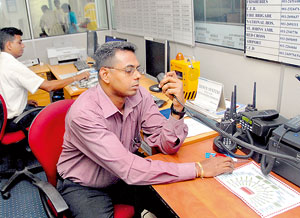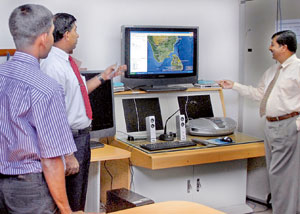Last week, as the biggest earthquake hit Japan, followed by the tsunami, some 50 countries in the Pacific basin issued warnings.Warnings went out to close neighbours such as the Philippines and Indonesia and other countries such as Russia, New Zealand, Australia, Papua New Guinea and Fiji.
Though no official warning was issued in Sri Lanka, the Disaster Management Centre (DMC) claimed with its disaster management and risk reduction plans Sri Lanka was ready to face natural calamities.
Mr. Hettiarachchi said that no drills were necessary and a tsunami warning was not issued on the basis that there was no direct threat to Sri Lanka.
“With any warning, we are capable of evacuating the entire coastal population to safety within 1 ½ - 2 hours if a tsunami warning is issued”, Disaster Management Centre (DMC) Director General Major General (Rtd.) Gamini Hettiarachchi told the Sunday Times.
He explained that there is an Emergency Operations Committee consisting of officials representing the institutions such as the Ceylon Electricity Board, Road Development Authority, Ports Authority, and Water Supply and Drainage Board which have to cope with emergency situations.
 |
| Officials on duty at the Disaster Management Centre.
Pix by Sanka Vidanagama |
Disruption of any service provided by these institutions will be reported by the respective representative in the committee so that steps are taken to minimise the inconvenience caused and normalcy restored. He added that discussions are being held to ‘fill the gaps’ of the Disaster Management Act to give more authority in decision making and taking legal action, but the complete implementation of the present Act has enabled the Disaster Management Centre to set up national, district, divisional secretariat area and grama niladhari division plans in handling catastrophes.
An Emergency Response Team for Chemical and Radiological Emergencies is being trained with the assistance of the National Atomic Energy Authority and the Organisation for the Prohibition of Chemical Weapons.
“With the limited capacity of the Atomic Energy Authority it cannot do much in case of radiation leaks. However, the new Response Team will consist of 20-30 members of the Army, Navy, Air Force and Fire Brigade. We are in the process of acquiring equipment for the team”, he said.
Reviewing recent disasters - except for the tsunami in 2004 - Sri Lanka experienced floods and landslides in 2003, 2007, 2008, 2010 and 2011.
Regarding the handling of flood situations, Director General Hettiarachchi said that 150 motor boats have been given to the local authorities. “During the floods in January and February the Navy used 47 boats for rescue operations”, he said.
However, when the Sunday Times team visited the flood affected areas in January, we learnt about people marooned in high altitude areas without any contact with the rest of the world and the Navy facing problems in reaching them to transport food and drinking water to them.
The vehicles transporting relief sent by the UN had to wait in Manampitiya in Polonnaruwa District unable to reach the flood victims in Batticaloa.
Other than the emergency operation plan, preparedness activities too have been launched in districts. Raising community awareness, social awareness, public servants’ awareness, community hazard mapping, community evacuation drills, search and rescue activities, first aid, fire fighting and dengue prevention are some of the activities conducted by the DMC, Maj. Gen. Hettiarachchi said.
He added that preparedness depends on the vulnerability of the District and therefore, all these activities do not take place in all the Districts. A Hospital Preparedness Plan was made on handling mass casualties, especially in bomb explosions, but it was put on hold last year as there aren’t any bomb explosions now.
Mitigation of floods, drought, landslides and animal attacks is another aspect of the disaster reduction plan. Maintenance of canal and drains, improving evacuation routes from flood prone areas, construction of agro-wells for drought mitigation, stabilisation of slopes in high risk landslide and rock-fall sites and construction of electrified fences to prevent animal attacks are several steps taken to mitigate disasters.
Regarding the early warning systems the Director General said that there are 50 Multi-Hazard Early Warning towers set up in Sri Lanka with 25 more to be set up within the year.
“We use telephones to inform the local bodies and police stations to warn of disasters and there is a 10-15 minute window before the telephone lines get jammed. We use that time to convey the message,” he said.
National Water Supply and Drainage Board Chairman Karunasena Hettiarachchi said that though the Board does not have a back up plan in case of a disaster, there is enough staff and equipment to attend to any disruption of the water service.
“Emergency arrangements are there to restore the system if any disruption occurs as ours is a 24 hour service. For example, considering Colombo which has a majority of the consumers, a 15 minute power failure could create a water shortage in the city,” he explained.
He said the water supply plants are interconnected so that if the Ambatale plant is damaged, the plant in Labugama will be able to provide water to some extent, if not totally. He said that with the opening of the Kelaniya plant in April, the system will be better equipped to face a disaster situation.
Meanwhile, Power and Energy Minister Champika Ranawaka, said that steps have been taken to minimize the injuries that could be caused by electricity during natural calamities such as floods, as the Ceylon Electricity Board could immediately cut off power to the areas that are facing the disaster
Special precautions have been taken to minimize the damages that could be caused by the high tension electricity lines in the coastal areas, he said adding that even the power plants are constructed in less inhabited areas.
Explaining the situation in Japan, he said that the nuclear plant in Japan was constructed to face an 8.5 magnitude earthquake but the 8.9 magnitude earthquake caused radiation leaks while the power plants in Sri Lanka are constructed to resist even a 9.0 magnitude earthquake.
Petroleum Industries Minister Susil Premajayantha said that the expansion of the Kolonnawa Oil Refinery will be at Muthurajawela, a less inhabited area, to minimize a disaster if any occurs.
Though it’s very difficult to minimize destruction from natural disasters as they are not preventable, refineries have been constructed to resist big earthquakes. “We have special squads trained to act immediately if a fire occurs,” he added.
Meanwhile, the Telecommunication Regulatory Commission (TRC) Director General Anusha Palpita said that immediately following the warning by the DMC of an approaching tsunami, the TRC has the facilities to send warning SMSes to its seven million customers.
“Avoiding the network jam, we can inform the police stations and other government institutions all over the country within 15 minutes”, he added that this new project has been launched in collaboration with the other telecommunication companies in the country.
Police Spokesperson Prishantha Jayakody said that in collaboration with the DMC, the police have set up an alarm system in every police station. “Moreover, policemen have been trained to locate safe areas to evacuate people to and handle unnecessary traffic jams,” he said.
The Director Planning of Sri Lanka Railways explained that all trains could be stopped within five minutes if an emergency situation is announced and thus, a repeat of the train tragedy during the 2004 tsunami could be averted.
“The engine drivers are provided CDMA phones and thus we will be able to contact them without any difficulty in an emergency situation,” he explained.
Meanwhile, Fisheries Minister Rajitha Senaratne said that all the fishing boat embarkation points in the country could be contacted within 20 minutes and thus they could inform the fishermen in time in an emergency situation. |



